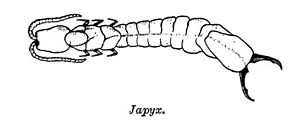Japygidae
| Japygidae | ||||||||||||
|---|---|---|---|---|---|---|---|---|---|---|---|---|

Habit of a member of the genus Japyx |
||||||||||||
| Systematics | ||||||||||||
|
||||||||||||
| Scientific name | ||||||||||||
| Japygidae | ||||||||||||
| Haliday , 1864 |
The Japygidae are a family within the double tails (Diplura). Compared to other double tails, the predominantly predatory Japygidae are characterized by the abdominal appendages, cerci , which are transformed into powerful pincers . The species are widespread worldwide and are found mainly in subtropical to tropical areas, where they mainly live in litter or under tree bark. Some of the species are cave dwellers (troglobionts).
features
The Japygidae, like all double- tailed arthropods , have an elongated body. The head has a pair of long articulated antennas made up of numerous uniform limbs . As is typical for the double tails, the piercing to piercing-scraping mouthparts are located in a head capsule typical of the Sackkiefler (Entognatha), eyes are not present.
The three-part chest area is equipped with three pairs of legs, the legs usually have two well-formed claws. The abdomen consists of 10 segments, the first seven of which have short remnants of extremities (styli) on the underside with evertable coxal vesicles. The last three abdominal segments have no leg rudiments, the genital opening is at the rear edge of the 8th abdominal sternite. The last segment of the abdomen is usually somewhat larger than the one in front of it and bears the cerci , which are typical of the family and which have been transformed into powerful grasping forceps .
The body of the Japygidae, which usually live in litter or underground, also in caves, is usually white to yellowish. They are usually a few millimeters to a few centimeters long.
Distribution areas
The Japygidae are distributed worldwide in temperate, subtropical and tropical climates. They occur on all continents with the exception of Antarctica . The main distribution is in warmer regions, so only a few species occur in Central Europe. In Germany species of a few heat-loving genera are common, including about Metajapyx leruthi Silvestri and Dipljapyx humberti (Grassi) .
Way of life
Japygidae, like all double tails, live mainly in litter, under tree bark and in the upper soil layers of various habitats. Numerous species live in the deeper layers of the soil, and many more are cave dwellers . They are predatory and feed mainly on smaller arthropods such as mites , springtails , small beetles and other insects.
Systematics
The Japygidae were in 1864 by the British entomologist Alexander Henry Haliday , together with the type genus Japyx as a separate family within the Diplura described . Today the family is divided into about 70 genera, some of which only contain one or a few species:
- Abjapyx Silvestri, 1948
- Afrojapyx Silvestri, 1948
- Allojapyx Silvestri, 1948
- Allurjapyx Silvestri, 1930
- Atlasjapyx Chou & Huang, 1986
- Austrjapyx Silvestri, 1948
- Burmjapyx Silvestri, 1931
- Catajapyx Silvestri, 1933
- Centrjapyx Silvestri, 1948
- Chiljapyx Smith, 1962
- Choujapyx Huang, 2001
- Congjapyx Pagés, 1954
- Ctenjapyx Silvestri, 1948
- Deutojapyx Paclt, 1957
- Dipljapyx Silvestri, 1948
- Ectasjapyx Silvestri, 1929
- Eojapyx Smith, 1960
- Epijapyx Silvestri, 1933
- Evalljapyx Silvestri, 1911
- Gallojapyx Pagés, 1993
- Gigasjapyx Chou, 1984
- Gollumjapyx Sendra & Ortuño, 2006
- Hainanjapyx Chou in Chou & Chen, 1983
- Hapljapyx Silvestri, 1948
- Hecajapyx Smith, 1959
- Henicjapyx Silvestri, 1948
- Heterojapyx Verhoeff, 1904
- Holjapyx Silvestri, 1948
- Hutanjapyx Pagés, 1995
- Indjapyx Silvestri, 1931
- Isojapyx Silvestri, 1948
- Japygellus Silvestri, 1930
- Japygianus Silvestri, 1947
- Japyginus Silvestri, 1930
- Japyx Haliday, 1864
- Kinabalujapyx Pagés, 1994
- Kohjapyx Pagés, 1953
- Megajapyx Verhoeff, 1904
- Merojapyx Silvestri, 1948
- Mesjapyx Silvestri, 1948
- Metajapyx Silvestri, 1933
- Mixojapyx Silvestri, 1933
- Monojapyx Paclt, 1957
- Nanojapyx Smith, 1959
- Nelsjapyx Smith, 1962
- Neojapyx Silvestri, 1933
- Notojapyx Paclt, 1957
- Occasjapyx Silvestri, 1948
- Oncojapyx Silvestri, 1948
- Opisthjapyx Silvestri, 1929
- Parindjapyx Silvestri, 1933
- Pauperojapyx Pagés, 1995
- Penjapyx Smith, 1962
- Polyjapyx Silvestri, 1948
- Proncojapyx Silvestri, 1948
- Protjapyx Silvestri, 1948
- Provalljapyx Silvestri, 1948
- Psalidojapyx Pagés, 2000
- Rectojapyx Pagés, 1954
- Rossjapyx Smith, 1962
- Scottojapyx Pagés, 1957
- Shaanxijapyx Chou in Chou & Chen, 1983
- Silvestriapyx Pagés, 1981
- Sinjapyx Silvestri, 1948
- Troglojapyx Pagés, 1980
- Typhlolabia Scudder, 1876
- Ultrajapyx Paclt, 1957
- Unjapyx Silvestri, 1948
- Urojapyx Pagés, 1955
- Xenjapyx Silvestri, 1948
supporting documents
- ↑ a b c A. Palissa: Diplura double tails. In: Exkursionsfauna von Deutschland, Spektrum Akademischer Verlag 2011; S 42. doi : 10.1007 / 978-3-8274-2452-5_6 , ISBN 978-3-8274-2451-8